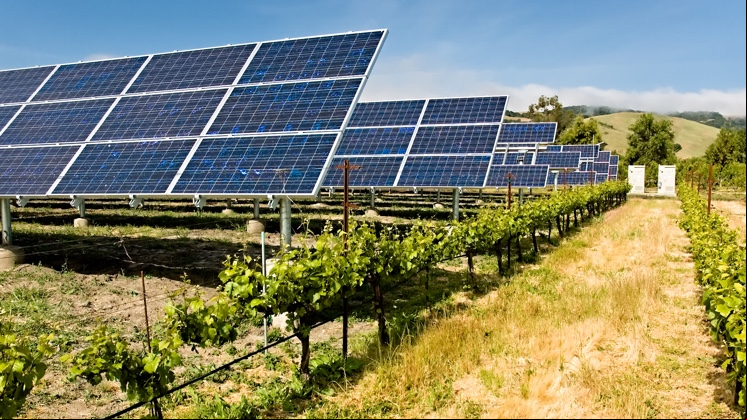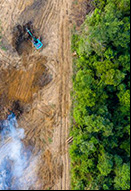Agrovoltaics 5l235e
Agrovoltaic energy, when agriculture and renewables go hand in hand 2v6911
Nature Renewable energy Biodiversity
Agrovoltaics, which seeks maximum synergy between photovoltaic energy and agriculture by installing solar s on farmland, is positioning itself as one of the benchmarks for making a sector that does not want to be left behind in the fight against climate change more sustainable. Below, we discuss its impact, as well as its characteristics and advantages.

Agrovoltaics will be fundamental in the transition toward more sustainable agriculture.
Climate change is the greatest threat hanging over humanity's future. The consumption of fossil fuels and activities linked to the agricultural sector are two of the biggest contributors to climate change because they emit greenhouse gases, which cause global warming. If the solution lies in renewable energy and sustainable agriculture, then why not combine the two? This exactly what agrovoltaics is all about.
What is agrovoltaic energy 384j3j
Agrovoltaic energy, also known as agrophotovoltaics, consists of using the same area of land to obtain both solar energy and agricultural products. In other words, solar s coexist with crops on the same surface. This technique was originally conceived by Adolf Goetzberger and Armin Zastrow in 1981, but the concept did not become popular until just last decade.
The shade from the s cast on crops can affect their productivity, since they receive slightly less light — although this can benefit certain crops — but energy production compensates for this loss. According to a study published by Nature External link, opens in new window., if just 1 % of arable land were dedicated to produce solar energy, it would be possible to offset the world's energy demand.
External link, opens in new window., if just 1 % of arable land were dedicated to produce solar energy, it would be possible to offset the world's energy demand.
The use of solar energy in agricultural areas also encourages photovoltaic self-consumption, since farms' energy needs can easily be met with the electricity generated. Agrovoltaics also has close links with smart farming, which improves productivity through technology like artificial intelligence, big data and the Internet of Things. In turn, it drives the development of smart villages.
In 2023, Iberdrola has won four agrovoltaic projects in the country. All of them are focused on the care of agriculture and livestock, in addition to the production of 12 MW. Kirch will seek to improve animal welfare while the Maubec, Lapenche and Solomiac projects will focus on improving agricultural plantations.

Innovation in renewables 4x2w3s
We innovate to improve the efficiency of our renewable assets.

Day for Biological Diversity 4z184a
Global commitment to nature.

Biodiversity protection 712v4i
We protect and preserve biodiversity on some of our projects.

Biodiversity loss 1v4m26
A risk for the environment and for humanity.
How does agrovoltaics work 596k1w
Generally, fixed systems are used to elevate the solar s about five metres above crop field. This allows farm machinery access to the crops below. Solar s can also be installed on greenhouse roofs. Another solution is dynamic agrovoltaics, which involves installing the s on elevated cables — a lighter alternative that is easy to disassemble — and allows the s to be moved or adjusted manually over the seasons and as the farmer cultivates different plots of land.
Other installations have monitoring systems, which allow the s to be orientated to maximise their efficiency and prevent them from always casting shade in the same place, thus adapting to the needs of the plants. These systems require complex software models that take things like crop growth phases and the weather into . In the future, solar s will be developed using semi-transparent polymers that allow the wavelengths of sunlight needed for photosynthesis to through and absorb the rest to generate energy.
Advantages and disadvantages of agrovoltaic energy 726z55
When it comes to the environment, the main benefit of agrovoltaics is that it reduces greenhouse gas emissions from the agricultural sector. What's more, the dual use of land for both agriculture and for energy relieves pressure on ecosystems and biodiversity, which are affected when cultivation areas are expanded.
Studies estimate that the electricity generated by solar s increases the economic value of agrovoltaic farms by more than 30 %, as it improves land-use efficiency and yields, as can be seen in the infographic. This is especially true in warmer areas, where the shade can protect crops by reducing temperatures and preventing excessive evaporation.
Agrovoltaic energy and its efficiency 354w6l
Thanks to the combined application of agriculture and photovoltaics, the landuse efficiency of the agrovoltaic system can reach 186%.
Separate use of agricultural land 5o6y1y
1 hectare of crops
1 hectare of solar s

100% agricultural product

100% solar electricity
Combined use of agricultural land 4214o
1 hectare of crops
and solar s
 SEE INFOGRAPHIC: Agrovoltaic energy and its efficiency [PDF]
SEE INFOGRAPHIC: Agrovoltaic energy and its efficiency [PDF]
As we have already mentioned, the main disadvantages of this energy source stem from the shade cast by the s, as this can affect crop productivity to varying degrees, forcing more resistant plants to be chosen and restricting those that are more dependent on sunlight. This also limits the latitudes where agrovoltaics work best, as in cooler areas, where sunlight intensity levels vary throughout the year, profitability can suffer. Other things to take into consideration are the high initial investment required — although this may fall as agrovoltaics takes hold — and the impact on the landscape.
Applications of agrovoltaics 4c5x6k
Agrovoltaics has many different applications depending on the environment and the intended use of the installations. Below, we review some of them:
Electricity production and crops 26k5s
Solar s share the same land as fruit, vegetables and cereals, which they protect from the atmospheric phenomena. This is the most common modality.
Electricity production and grazing 1f6y48
On non-arable land, or where the climate is less suitable for growing crops, the ground beneath the solar s can be used for livestock grazing.
Electricity production, fresh water and crops 10312
Three-in-one use suited to coastal areas. The electricity generated is used to power a desalination plant that produces water for the crops and for human consumption.
Energy that changes lives 4w336a
At Iberdrola España we believe that to inspire you have to tell stories. Stories that change lives.
Discover the webseries Energy that changes lives, created to share Iberdrola's inspiring stories in the most diverse corners of Spain. Find out how clean energy helps children with cerebral palsy, the neighbourhood of an inclusive education school and a sustainable vineyard from Concha, Elvira and Miguel.





